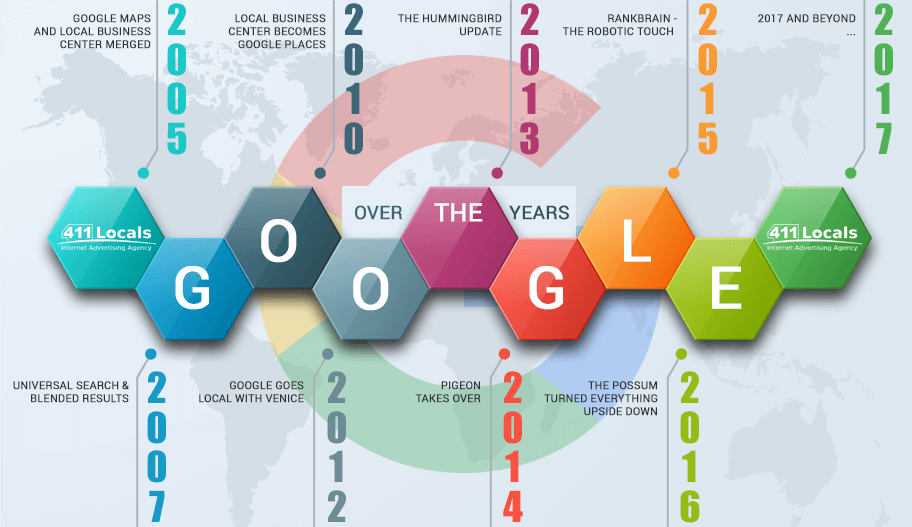
We all know how fast Google changes algorithms and deciphering it might feel like an exercise in futility. This is why, we at 411 Locals, keep track of the algorithm changes and try to synthesize it for every SEO enthusiast. It is a well-known fact how many changes Google has made over the years, and on this page you will show you the brief history of those changes starting with the year of 2005.
2005: Google Maps and Local Business Center Merged
We all remember when Google released the Local Business Center in March 2005. The next logical step was to merge this free tool helping business to easily add or update their business listing that appear in google Local with Google Maps. The users could now easily condense relevant search results into a single location that included store hours, contact information, and driving directions.
2007: Universal Search & Blended Results
When Google released the “Universal Search” system, it was considered the most radical change they have ever made. The systems blends listings from its news, images, video, local and book search engines among those it gathers from crawling web pages.
2010: Local Business Center becomes Google Places
Google Local Business Center was rebranded into Google Places. The reason for this was that it was easier to connect Google Place Pages with the place where local business information is claimed. The rebranding of the name included many important updates, such as adding new image features, local advertising options, the availability of geo-specific tags for certain markets, and many others. One of the most important updates was the attempt to align Places pages with localizes search results as there was previous information with localizes results coming from Google Maps.
2012: Google Goes Local with Venice
Simply put, this update, localized the organic results on broad search queries. In other words, Google included local results regardless of whether you have actively set your location or not. You will even get localizes results searching from a cookie free, incognito browser session. That really made the SEO industry seem a little bit pointless, it was too good to be true.
2013: The Hummingbird Update
The Hummingbird brought drastic changes to Google’s semantic search capabilities. This means that ever since the Hummingbird spread its wings, Google can better understand long-tail queries which allows users to be more specific with their questions.
2014: Pigeon Takes Over
The Pigeon update furtherly defined how business ranked on localizes search engine results pages. Refining local search results, Pigeon allowed alignment of the local searches directly with the traditional SEO ranking signals, which led to more accurate returns on user queries.
2015: RankBrain – The Robotic Touch
This is another great breakthrough. The artificial intelligence of the RankBrain update, allowed the Google Search Engine to essentially teach itself how to process queries and results more accurately and effectively.
2016: The Possum Turned Everything Upside Down
This update limited local search results for business in a specific geographical area. For example, if a store in a nearby area but just outside the city limits of Las Vegas, for instance, would have been ranked difficult and hardly appear on queries that explicitly included the string “Las Vegas”.
2017 and beyond
Of course, there is no way to predict where the next major SEO changes will occur as Google rarely announces the updates anymore. However, we at 411, Locals have a few tips for you that will never go out of fashion.
- Mark up locations with structured data, location, and hours.
- Stick to organic searches and cultivate localized content.
- Manage your local listings for name, address, and phone number.
We hope that was helpful and brought back memories, or you learned something new. 411 Locals will keep posting about any new updated and other related blogs. Stay with us!


